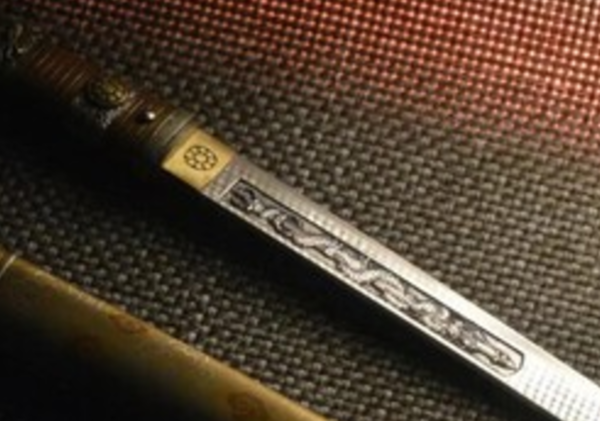-
Posts
12,896 -
Joined
-
Last visited
-
Days Won
154
Everything posted by Bruce Pennington
-
It is definitely a WWII blade. The large Seki stamp was only used between 1940 and 1944. Most blades with date, bearing the stamp were made in 1942. Posting a couple of photos for posterity.
-
That's cool, Sam! Did you get a reading on that mon?
-
Did some digging in Sesko's list. He doesn't have any Kanesada using 兼㝎, not that this by itself is conclusive, but he actually has one using the exact same full mei as the one in your link: "KANESADA (兼定), Kanbun (寛文, 1661-1673), Musashi – “Bushū-jū Izumi no Kami Kanesada” (武州住和泉守兼定), “Kanesada” (兼定), “Izumi no Kami Minamoto Kanesada” (和泉守源兼定)"
-
Got it, Mal, thanks! I'm still only half-way through Part 1! I like your writing, and your research is incredible. Much appreciated!
-
-

Why are Mon so rare on Kai Gunto?
Bruce Pennington replied to PNSSHOGUN's topic in Military Swords of Japan
Here's one on a Tenshozan Forge kaigunto, owned by @mdiddy Matt, source - @mecox Mal's Japanese Naval Swords, Part 1 -
Excellent, thanks! BTW, I use the term in the most academic sense - that I am totally uneducated about so-and-so - ignorant of needed knowledge.
-
Forgive my ignorance, but all I know about "Kyu" is it means "old" as in Kyu-gunto vs Shin (new)-gunto. Does this mean something else?
-
A clarification by @uwe : "Not Kiku, Bruce, but “Kyū-Mon” (or hoshi ). Can’t tell if Hosokawa-kyū, Kokumochi-kyū or Maru ni kyū, though…"
-
That's quite a sword, you have there Sam! We could use a clear photo showing the blade, but from what I can make out, it does resemble this Murata-to on this Ohmura Page
-

Highly dubious Type 94 on Yahoo!
Bruce Pennington replied to KungFooey's topic in Military Swords of Japan
Plum blossoms and ducks! Wonder what that means? Beautiful custom 94. -

Help with Grass Script, Please!
Bruce Pennington replied to Bruce Pennington's topic in Translation Assistance
Ah Ha! @John C found a document from the Kokura Arsenal showing various tensho script inspector marks on Nambu pistols: -

Help with Grass Script, Please!
Bruce Pennington replied to Bruce Pennington's topic in Translation Assistance
Response from Guy, at Warrelics: "That is seal script [tensho 篆書] and looks like Hori to me: 堀" -

Sword from Japanese surrender WW2 Saigon.
Bruce Pennington replied to SimonAitch's topic in Translation Assistance
Without a surrender tag, there is no way to know who carried this. You are now the rightful owner. -
-
Even an 8 petal Kiku mon on the habaki!
-
Mikko, You are right, however there are always exception. Out of 400+ Mantetsu, I have 3 waki on file, 2 look to have been made that way Out of over 700+ stamped blades, I have 4 or 5 waki that look to have been made that way. So yes, if you see a waki fitted for the war, it was likely an older blade, brought or bought or donated for the war.
-
@John C found this on a Type 25 Cavalry ricasso. Any help?
-
Yeow! Look at those! Yeah, I'm going to have to change the thread title to "Cat Scratch Skirting Boards" now! Ha!
-
Brian and Mal answered it, but just adding that it is rare, but not unheard-of. I've seen good luck slogans, Buddhist notations, horimono, even school graduation notations. Oliver got it. All the high-tech spell checking, and other software can't help us if we type something wrong that's spelled right!
-
And now they seem to be popping up! This one posted by @Newsword1 HERE.
-
Great photo of an Army NCO aviator with his full-length Type 95! Found on this Wehrmacht-awards Thread.
-
Here's what Sesko has on him: "TOSHIHIDE (俊秀), Shōwa (昭和, 1926-1989), Hokkaidō – “Ōmi no Kuni Shiga Tarō Minamoto Hideaki” (近江国志賀太郎源秀明), “Minamoto Toshihide” (源俊秀), “Zuisen Horii Toshihide” (瑞泉堀井俊秀), real name Horii Kaneyoshi (堀井兼吉), he was born on the second day of the third month Meiji 19 (明治, 1886) in the village of Shimosaka (下坂) in Shiga Prefecture, 1905 he entered an apprenticeship under Horii Taneaki (堀井胤明), he signed in early years with Hideaki (秀明), a name that was granted to him in 1913 by the NBTHK, 1911 he married the daughter of Taneaki and was adopted into the Horii family, thereupon he changed his name to Shiga Tarō (志賀太郎), the name change of the smith name to Toshihide took place in December 1933 with the birth of emperor Akihito (明仁) because he refrained out of respect from using the same character of “Aki” (明), he died in 1943, shinpin no retsu (Akihide), Special Honor Seat at the 6th Shinsaku Nihontō Denrankai (新作日本刀展覧会, 1941)" Your blade is dated June 1929, so pretty early for a WWII smith. The sword is a Type 97 Japanese Naval officer's sword. You can read about them on Ohmura's site here: Naval Commissioned Officers Sword - Ohmura The tsuba (handguard) is civilian, so unusual to see on a Navy kaigunto. Maybe it was something the officer brought from home.



.thumb.jpg.994c943a1b1f4908d731d9ee6dbb5ecb.jpg)










